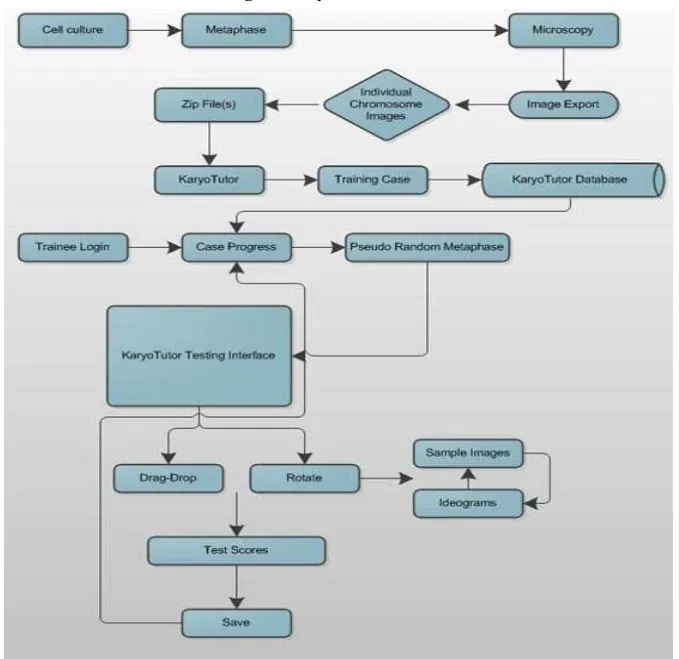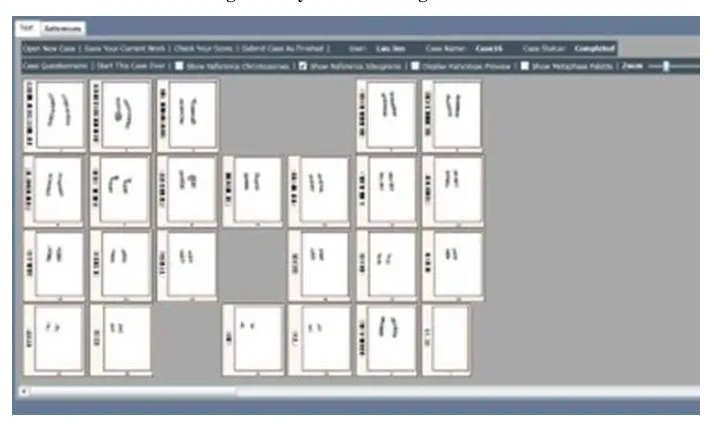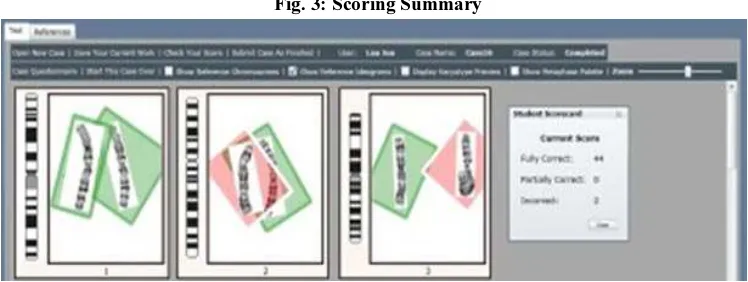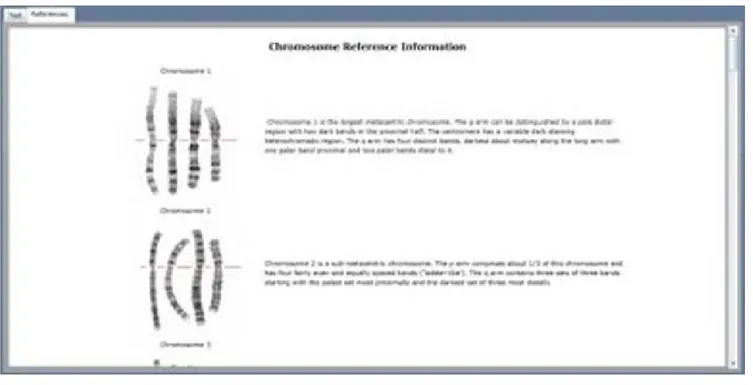LETTER TO EDITOR
Interactive Karyotyping Training
Ashwin Kotwaliwale*
Genomic Software, Inc., 10315 Alpine Drive, #2 Cupertino, CA 95014, USA
Abstract:
Despite the wide use of newer techniques in genetic diagnostics, there remains a need for technologists to learn human chromosome morphology, identify abnormal metaphases and report clinical abnormalities. Global shortage of cytogenetic trainers and a time consuming training process makes Karyotyping training difficult. We have developed a web based in-teractive Karyotyping training tool, KaryoTutor ©, that allows technologists to learn karyotyp-ing in an interactive environment and aids the trainer in the training process. KaryoTutor© provides visual clues for identifying abnormal chromosomes, provides instant test scores and includes a reference library of ideograms, sample chromosome images and reference materials. Trainees are able to recursively work on a case till a satisfactory result is achieved, with KaryoTutor providing interactive inputs. Additionally, trainers can assign cases and moni-tor trainee progress using audit trail manage-ment and other administrative features.
Keywords: Cytogenetic Education,
Chromo-some Analysis, Interactive Karyotyping, Train-ing, Genetics TrainingInteractive Karyotyping Training
Salient Features
• Karyotyping is an important step of diag-nosing genetic disorders and often very dif-ficult to learn, Karyotutor makes the learn-ing process simple and efficient.
• Karyotutor provides a simple way for train-ers to create training sets and for students to work on cases from anywhere at any con-venient time.
• Karyotutor provides an easy, intuitive inter-face for students to work with and allows for interactive feedback defining the cor-rectness of each chromosome image as well as the entire case, providing a score. • Karyotutor enhances the training process by
providing easy access to a reference library as well as sample chromosome images. • Karyotutor allows the trainer to audit each
trainees progress, thereby allowing an ef-ficient grading system.
Ó
Journal of Krishna Institute of Medical Sciences University The aim of this communication is to define thesalient features of KaryoTutor and its applica-bility in cytogenetic training. The definition of trainer side functionality is beyond the scope of this communication.
Cytogenetic laboratories process cell culture based metaphase spreads and prepare karyo-types upon which genetic reports are published. Image analysis software is used to rapidly cut out chromosome images from metaphase spread images and arrange them on a karyotype template. The segmentation and arrangement algorithm employ pattern recognition tech-niques of banded chromosomes, comparing them to a standard library and thus determining the chromosome number [4]. It may be conve-nient to believe that such software packages can solve all issues related to chromosome identi-fication, however, this is usually not the case for complex chromosomal rearrangement such as deletions, translocations, partial trisomies and ring chromosomes, thus requiring human intervention. Shortcomings of such algorithm processes create a continuous requirement for trained staff which form the basis of genetics training in the age of automation and software powered technologies.
Efficient manpower and training tools are re-quired to continue genetic training. Global shortage of trainers and the difficulty of train-ing aspects such as fundtrain-ing and core resources make it a necessity to have smart software tools to aid in the process of training.
The authors are of the opinion that software technologies can be used to address a part of the training process. To address these training needs we have developed KaryoTutor [5] which is first of a kind, innovative, unique and
inter-148
active cytogenetic training software, specifi-cally designed to teach genetic technologists to learn human chromosome morphology and perform Karyotyping as a part of their voca-tional training.
KaryoTutor is a web based application devel-oped using Microsoft Silver light 3 [6], Microsoft. NET 3.5 [7] and SQL Server 2008 R2 [8]. Silver light is a modern browser plug in that installs on all operating systems. It allows for silver light applications to execute on the client computer, thereby utilizing the CPU power of the client computer. Additionally, sil-ver light being a plug in system, works within the browsers sandbox and has access to a sub-set of the operating systems API such as those required for graphics rendering. These were important design considerations as smooth dragging-dropping, image rotation, and zoom-ing of chromosome images, are required for Karyotyping. The user interface was designed to address these requirements and silver light met the requirements out-of-the-box.
as it allows for simple serialization and deserialization of entity objects.
Before commencing a training session in KaryoTutor, minimal preparatory work is re-quired; this starts with the account administra-tor creating accounts for trainers and students. For trainees to use KaryoTutor, training sets have to be made available. We provide over one hundred cases which have been selected by
cy-Fig. 1: KaryoTutor Workflow
Ó
Journal of Krishna Institute of Medical Sciences University 150arm upward and its q arm in the downward ori-entation as they would normally appear on a karyotype. Its is image naming nomenclature that KaryoTutor employs to validate student re-sponses as its able to infer the actual chromo-some number and the corresponding slot in which the image was placed by the trainee. The overall workflow that addresses trainer and trainee functionality is outlined in Fig. 1. A training session in KaryoTutor starts with the trainee using an internet connected computer to login into her account and select an assigned case to work on. Initially, all chromosome im-ages are randomly placed onto a metaphase window. Since we do not store exact locations of each chromosome image as it is found in the original metaphase, KaryoTutor creates a pseudo-random metaphase that simulates a metaphase as seen under a microscope. The
Fig. 2: KaryoTutor Testing Interface
trainees then assign each chromosome image numbers that they thinks correctly identifies the chromosome. The trainee has the function-ality to rotate the chromosome image in the metaphase window. Each of the chromosome images can then be transferred to the karyotype template using the export feature, such that each chromosome is placed onto its own slot on the karyotype template as shown in Fig. 2.
The process of moving chromosomes until a desired result is obtained can be continued in-definitely. At any stage in the training process the users may save their work to finish later. The core functionality of KaryoTutor is to pro-vide instant feedback to the trainee. According to the International Standard Chromosome No-menclature (ISCN) rules, a chromosome is
Fig. 3: Scoring Summary
Fig. 4: Completed Case
Ó
Journal of Krishna Institute of Medical Sciences University have incorrect degree of rotation. We allow for20 degrees of rotational freedom before a chromosome is considered incorrect. A sample scoring summary is provided in Fig. 3.
The results are displayed as a scorecard in a popup window. (Fig. 5)
Several other visual clues required for identi-fying chromosomes such as reference images and ideogram references are also provided as shown in Fig. 4.
Reference images and ideogram references are also placed adjacent to each chromosome im-age box that the trainee can turn on or off as desired. Other features included the ability to move chromosome images from one location to another, save the state of the case, reload the case, and access a reference image library and textual description of each chromosome im-age. A sample of a complete case is shown in Fig. 5.
Discussion:
Fig. 5: Reference Library
KaryoTutor is in use at several institutions and is used by trainees undergoing vocational train-ing as well as trainees undertaktrain-ing undergradu-ate courses. In both instances trainers are able to successfully assign cases and trainees are able to perform interactive karyotyping, gen-erating test scores and completing assigned course work as shown in Fig. 6. In the follow-ing section we discuss some of the shortcom-ings of KaryoTutor when used in a multiuser scenario and we make design recommendations based on identified technical drawbacks and user feedback.
Since the starting material for KaryoTutor cases is a set of predefined images, there is a limita-tion for chromosome identificalimita-tion when chro-mosome crossovers are encountered. In the real world, when a trainee encounters a chro-mosome crossover situation, which typically involves a pair of chromosomes and appears as X under a microscope, they may think of sev-eral possibilities such as the left arms on an
X could be one chromosome or the top V of an X could be another possibility. In KaryoTutor, such an experience is not encoun-tered because each chromosome is a predefined imaged, thereby allowing the trainee to simply mouse point each image and identify.
Modern HTML technologies such as HTML 5 [11] have limited support for graphics, whereas other plugin systems such as Adobe Flash [12], meant primarily for graphics applications lack convenient database connectivity modules, in consideration, silver light was chosen as it runs on a subset of the NET Framework and is tightly integrated with NET for easy data access. We decided to use an n-tier development pattern for architecting KaryoTutor. The database was developed using a RDBMS pattern in Microsoft SQL Server 2008 as it offered scalability, se-curity and reliability. The middle tier which encompasses the business logic was coded in NET 3.5 using both C# and VB.NET.Silverlight was used to develop the entire user interface(s) as it also allows execution of native operating system functions such as smooth drag-drop. Since KaryoTutor score functional require-ment was to allow image manipulation, silverlight was able to meet our design require-ments.
Trainees are required to place chromosome images in close proximity as defined by ISCN. Images are rendered as rectangles wherein each pixel is given a color. G banded chromosome images are always black-white images with the chromosomes placed centrally and in black-white bands surrounded by a black-white area in each chromosome image. The presence of this white area would not allow for close image proxim-ity, thereby preventing overlapping of chromo-some images. This is due to one of the limita-tions of KaryoTutor (and Silverlight) that .png
image format transparency is not fully ad-dressed. The solution to this problem is to make each images background transparent using an image editing tool. Additionally, Silverlight does not natively support image rotation. To accom-plish this, we used template list box controls and added custom behaviour to allow for rota-tion. The effect was that the image rotation was handled with limited success, although trainees were able to accomplish adequate image rota-tion with continual practice.
KaryoTutor allows storage of all the informa-tion related to every case which leads to re-quests for several database transactions. We noticed that sporadically, state data was not be-ing saved, and considered that WCF time-out was the reason. Since we used entity framework for database modeling, each SQL query is con-verted from a class definition to native SQL syntax; such generated SQL query by design is complex and parsing it might also contribute to failed database transaction. One way to solve this issue would be to increase WCF timeout. KaryoTutor was designed to work with a range of chromosome images which are used as edu-cational material. However, when very long images were loaded (prometaphase chromo-some images), it was noticed that the edges of the chromosomes were often cropped when placed in their image slot. This is because chro-mosome slot dimensions were determined at design time and thus did not take into account images whose dimensions would exceed the slot dimensions. This limitation is illustrated in Fig. 7. To overcome this issue we plan to dy-namically adjust the size of the image slot in which the image is dropped.
Ó
Journal of Krishna Institute of Medical Sciences University each case such as the score and the number oftimes the trainee tested their identifications. At times, the audit trail interface would become unresponsive due to the number of records be-ing returned from the database. In future re-leases of NET, asynchronous operations are bet-ter supported and we plan to integrate code that would load data in chunks as opposed to a single dataset.
We developed KaryoTutor to aid the cytogenet-ics training community in their efforts. While there are several lacunae that we have to fully optimize, KaryoTutor is being successfully used in its third year having trained several hundred trainees to date.
Readers can access a demo of KaryoTutor at http://www.karyotutor.us/demo/karyotutor.aspx
Acknowledgements
We would like to thank John Mann MD, Barry Winnett, Dr. Lauren Jenkins, Mike Griffiths and Calvin Schrotenboer and for their valuable con-tributions to KaryoTutor.
KaryoTutor development was fully funded by Genomic Software Inc.
References:
1. National Human Genome Research Institute 2011. Fluorescence In Situ Hybridization (FISH). Retrieved 2011, from genome.gov: http://www.genome.gov/10000206
2. Manning, MM 2010. Array-based technol-ogy and recommendations for utilization in medical genetics practice for detection of chromosomal abnormalities. Genetics in Medicine: 742.
3. Ishkanian, AS 2004. A tiling resolution DNA microarray with complete coverage of the human genome. Nature Genetics: 299-303. 4. Piper, J. 2005. On fully automatic feature
measurement for banded chromosome clas-sification. Cytometry: 242-255.
5. Genomic Software. 2007. KaryoTutor. Retrieved 2011, from KaryoTutor - Ge-nomic Software: http:// www.karyotutor.com
6. Microsoft Corporation. 2006. Silverlight. Retrieved 2011, from Silverlight: http:// www.silverlight.net/
7. Microsoft Corporation. 2011. NET. Re-trieved 2011, from Microsoft .NET: http:// www.microsoft.com/net
8. Microsoft Corporation. 2009. SQL Server. Retrieved 2011, from Microsoft SQL Server: http://www.microsoft.com/ sqlserver/en/us/default.aspx
9. Microsoft Corporation. 2008. ADO.NET Entity Framework. Retrieved 2011, from The ADO.NET Entity Framework Overview: http://msdn.microsoft.com/en-us/library/ aa697427(v=vs.80).aspx
10. Microsoft Corporation. 2008. WCF. Re-trieved 2011, from Windows Communica-tion FoundaCommunica-tion is: http:// msdn.microsoft.com/en-us/netframework/ aa663324
11. Wikipedia. 2011. HTML 5. Retrieved 2011, from HTML 5: http://en.wikipedia.org/wiki/ HTML5
12. Adobe. 2011. Adobe Flash Player 11. Re-trieved 2011, from Adobe Flash: http:// www.adobe.com/products/flashplayer.html
*Author for Correspondence: Ashwin Kotwaliwale, Genomic Software, Inc.10315 Alpine Drive, #2 Cupertino, CA 95014, Email:ak@genomicsoftware.com



